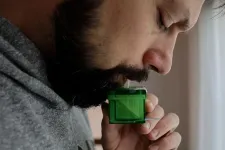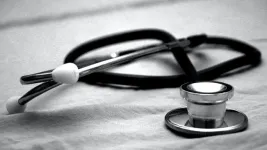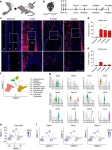(Press-News.org) Scientists at Washington University in St. Louis have developed a breath test that quickly identifies those who are infected with the virus that causes COVID-19. The device requires only one or two breaths and provides results in less than a minute.
The study is available online in the journal ACS Sensors. The same group of researchers recently published a paper in the journal Nature Communications about an air monitor they had built to detect airborne SARS-CoV-2 — the virus that causes COVID-19 — within about five minutes in hospitals, schools and other public places.
The new study is about a breath test that could become a tool for use in doctors’ offices to quickly diagnose people infected with the virus. If and when new strains of COVID-19 or other airborne pathogenic diseases arise, such devices also could be used to screen people at public events. The researchers said the breath test also has potential to help prevent outbreaks in situations where many people live or interact in close quarters — for example aboard ships, in nursing homes, in residence halls at colleges and universities or on military bases.
“With this test, there are no nasal swabs and no waiting 15 minutes for results, as with home tests,” said co-corresponding author Rajan K. Chakrabarty, PhD, the Harold D. Jolley Career Development Associate Professor of Energy, Environment & Chemical Engineering at the McKelvey School of Engineering. “A person simply blows into a tube in the device, and an electrochemical biosensor detects whether the virus is there. Results are available in about a minute.”
The biosensor used in the device was adapted from an Alzheimer’s disease-related technology developed by scientists at Washington University School of Medicine in St. Louis to detect amyloid beta and other Alzheimer’s disease-related proteins in the brains of mice. The School of Medicine’s John R. Cirrito, PhD, a professor of neurology, and Carla M. Yuede, PhD, an associate professor of psychiatry — both also co-corresponding authors on the study — used a nanobody, an antibody from llamas, to detect the virus that causes COVID-19.
Chakrabarty and Cirrito said the breath test could be modified to simultaneously detect other viruses, including influenza and respiratory syncytial virus (RSV). They also believe they can develop a biodetector for any newly emerging pathogen within two weeks of receiving samples of it.
“It’s a bit like a breathalyzer test that an impaired driver might be given,” Cirrito said. “And, for example, if people are in line to enter a hospital, a sports arena or the White House Situation Room, 15-minute nasal swab tests aren’t practical, and PCR tests take even longer. Plus, home tests are about 60% to 70% accurate, and they produce a lot of false negatives. This device will have diagnostic accuracy.”
The researchers began working on the breath test device — made with 3D printers — after receiving a grant from the National Institutes of Health (NIH) in August 2020, during the first year of the pandemic. Since receiving the grant, they’ve tested prototypes in the laboratory and in the Washington University Infectious Diseases Clinical Research Unit. The team continues to test the device, to further improve its efficacy at detecting the virus in people.
For the study, the research team tested COVID-positive individuals, each of whom exhaled into the device two, four or eight times. The breath test produced no false negatives and gave accurate reads after two breaths from each person tested. The clinical study is ongoing to test COVID-positive and -negative individuals to further test and optimize the device.
The researchers also found that the breath test successfully detected several different strains of SARS-CoV-2, including the original strain and the omicron variant, and their clinical studies are measuring active strains in the St. Louis area.
To conduct the breath test, the researchers insert a straw into the device. A patient blows into the straw, and then aerosols from the person’s breath collect on a biosensor inside the device. The device then is plugged into a small machine that reads signals from the biosensor, and in less than a minute, the machine reveals a positive or negative finding of COVID-19.
Clinical studies are continuing, and the researchers soon plan to employ the device in clinics beyond Washington University’s Infectious Diseases Clinical Research Unit. In addition, Y2X Life Sciences, a New York-based company, has an exclusive option to license the technology. That company has consulted with the research team from the beginning of the project and during the device’s design stages to facilitate possible commercialization of the test in the future.
Ghumra DP, Nishit, S, McBrearty KR, Puthussery JV, Sumlin BJ, Gardiner W, Doherty BM, Magrecki JP, Brody DL, Esparza TJ, O’Halloran J, Presti R, Bricker TL, Boon ACM, Yuede CM, Cirrito, JR, Chakrabarty RK. Rapid direct detection of SARS-CoV-2 aerosols in exhaled breath at the point-of-care. ACS Sensors, July 27, 2023. https://doi.org/10.1021/acssensors.3c00512
The study was funded by the National Institutes of Health (NIH) RADx-Rad program. Grant numbers U01 AA029331 and U01 AA029331-S1. Additional funding from the National Institute of Neurological Disorders and Stroke Intramural Research Program, the Uniformed Services University of Health Sciences and the NIH SARS-CoV-2 Assessment of Viral Evolution (SAVE) Program.
About Washington University School of Medicine
WashU Medicine is a global leader in academic medicine, including biomedical research, patient care and educational programs with 2,800 faculty. Its National Institutes of Health (NIH) research funding portfolio is the third largest among U.S. medical schools, has grown 52% in the last six years, and, together with institutional investment, WashU Medicine commits well over $1 billion annually to basic and clinical research innovation and training. Its faculty practice is consistently within the top five in the country, with more than 1,800 faculty physicians practicing at 65 locations and who are also the medical staffs of Barnes-Jewish and St. Louis Children’s hospitals of BJC HealthCare. WashU Medicine has a storied history in MD/PhD training, recently dedicated $100 million to scholarships and curriculum renewal for its medical students, and is home to top-notch training programs in every medical subspecialty as well as physical therapy, occupational therapy, and audiology and communications sciences.
The McKelvey School of Engineering at Washington University in St. Louis promotes independent inquiry and education with an emphasis on scientific excellence, innovation and collaboration without boundaries. McKelvey Engineering has top-ranked research and graduate programs across departments, particularly in biomedical engineering, environmental engineering and computing, and has one of the most selective undergraduate programs in the country. With 165 full-time faculty, 1,420 undergraduate students, 1,614 graduate students and 21,000 living alumni, we are working to solve some of society’s greatest challenges; to prepare students to become leaders and innovate throughout their careers; and to be a catalyst of economic development for the St. Louis region and beyond.
END
Scientists develop breath test that rapidly detects COVID-19 virus
Test results available in less than a minute
2023-08-01
ELSE PRESS RELEASES FROM THIS DATE:
Sex pheromone of moths is a precise mix of ingredients
2023-08-01
Researchers from the UvA and North Carolina State University have identified the specific mixture of pheromone chemicals that male moths use during courtship. The findings provide more detail about the complex blend of chemicals that males and females of this group of moths use in fundamental short-range communication. The publication in the scientific journal Current Biology appeared on 1 August.
Scent compounds are essential for male moths to entice female conspecifics to mate. Both partners need to find and recognize each other in the dark. This is done by sex pheromones secreted by the female. Then it is up to the male to convince the female ...
Study characterizes unique immune response in patients who experience inflammatory arthritis as side effect of cancer therapies
2023-08-01
Immune checkpoint inhibitor (ICI) therapies used to treat cancer come with the risk of adverse autoimmune responses, including arthritis that can persist for years and require joint replacement surgery. Little is known about the specific cells responsible for these events. Researchers at Brigham and Women’s Hospital, a founding member of the Mass General Brigham healthcare system, and collaborators led a study to investigate these immune adverse events and identified a specific type of CD8 T cell that characterizes inflammatory arthritis induced by ICI therapies.
Researchers ...
Three doses of COVID-19 vaccine leads to catch-up antibody responses among the particularly vulnerable
2023-08-01
Even vulnerable people, who are at risk of severe Covid-19, achieved good antibody levels after three doses of mRNA vaccine. This is shown by a study from the University of Gothenburg on patients having undergone a bone marrow transplant or with liver disease, including cirrhosis.
The aim of the study, which has been published in the journal Infectious Diseases, was to investigate the effects of repeated vaccinations and hybrid immunity against Covid-19 among particularly vulnerable individuals. Hybrid immunity refers to the protection provided by vaccination in combination with SARS-CoV-2 ...
UCSF Medical Center is among nation’s top hospitals for 2023-24
2023-08-01
UCSF Medical Center Is Among Nation’s Top Hospitals for 2023-24
U.S. News & World Report ranks UCSF Health adult care among nation’s top 10 hospitals in 7 specialties, Best in the West for neurology/neurosurgery and rheumatology
UCSF Medical Center has been named to the Honor Roll of the nation’s top hospitals for adult care in U.S. News & World Report’s 2023-24 Best Hospitals rankings, representing the highest quality of care and safety standards in the country.
The distinction was earned by only 22 medical ...
Immigrant nurses in long-term care facilities often have more “human capital” compared to American-born nurses, MU researcher finds
2023-08-01
COLUMBIA, Mo. -- When assessing the skills and competencies or “human capital” of long-term care registered nurses in the United States, studies often focus solely on years of experience and traditional educational backgrounds. However, a new study conducted by a nurse scientist now at University of Missouri found that by incorporating additional criteria, such as ability to speak multiple languages, additional certificates or trainings and licenses to practice in multiple states, immigrant nurses often represent far more human capital than their American-born counterparts.
Roy Thompson, a postdoctoral fellow in the MU Sinclair School of Nursing ...
New insights into heterotopic ossification: Progenitor cells play a key role in aberrant bone formation
2023-08-01
In a new study published on 21 July 2023 by the journal Bone Research, a team of researchers from Johns Hopkins University, using a combination of lineage tracing and single-cell RNA sequencing (scRNA-seq), delved into the contribution of synovial/tendon sheath progenitor cells to heterotopic bone formation. The researchers identified a distinct population of Tppp3+ tendon progenitor cells that actively participated in the formation of ectopic bone in vivo. Their findings provide new insights into the intricate cellular processes driving heterotopic ossification and offer potential therapeutic targets to prevent and ...
Where Black adolescents live affects their mental health
2023-08-01
It’s easy to imagine that growing up in a neighborhood with safe and clean parks, little to no discrimination, and where people are not struggling financially makes for a lower-stress childhood. In contrast, neighborhoods with few community spaces, violence, and poverty create a higher-stress environment for a child to live in. Unfortunately, systemic and structural issues such as wealth inequality, residential segregation, barriers to home ownership, and environmental injustice in neighborhoods where Black American adolescents disproportionately reside make ...
Amazon dark earth boosts tree growth as much as sixfold
2023-08-01
A type of soil called terra preta da Amazônia, or Amazon dark earth (ADE), promotes faster growth of trees and enhances their development in qualitative terms, according to an article published in the journal Frontiers in Soil Science.
The findings reported in the article resulted from studies supported by FAPESP (projects 20/08927-0, 18/19000-4 and 14/50320-4) under the aegis of its Biodiversity, Characterization, Conservation, Restoration and Sustainable Use Program (BIOTA).
“ADE is rich in nutrients and supports communities of microorganisms that help plants grow, among other things. Native people of the Amazon have ...
Sweet smell of success: Simple fragrance method produces major memory boost
2023-08-01
Irvine, Calif., Aug. 1, 2023 — When a fragrance wafted through the bedrooms of older adults for two hours every night for six months, memories skyrocketed. Participants in this study by University of California, Irvine neuroscientists reaped a 226% increase in cognitive capacity compared to the control group. The researchers say the finding transforms the long-known tie between smell and memory into an easy, non-invasive technique for strengthening memory and potentially deterring dementia.
The team’s study appears in Frontiers in Neuroscience. ...
Links between attention and conscious perception highlighted in frontoparietal networks
2023-08-01
Almost half of patients who experienced a stroke in the right cerebral hemisphere later develop a very unusual symptom: they lose the ability to perceive what is happening in the left side of space. As a result, they tend to eat only the right side of their plate, ignore people on their left, and have great difficulty finding their way around. This disorder, known as hemispatial neglect, does not involve basic visual abilities, which remain intact.
“These patients see very well. The problem ...
LAST 30 PRESS RELEASES:
Numbers in our sights affect how we perceive space
SIMJ announces global collaborative book project in commemoration of its 75th anniversary
Air pollution exposure and birth weight
Obstructive sleep apnea risk and mental health conditions among older adults
How talking slows eye movements behind the wheel
The Ceramic Society of Japan’s Oxoate Ceramics Research Association launches new international book project
Heart-brain connection: international study reveals the role of the vagus nerve in keeping the heart young
Researchers identify Rb1 as a predictive biomarker for a new therapeutic strategy in some breast cancers
Survey reveals ethical gaps slowing AI adoption in pediatric surgery
Stimulant ADHD medications work differently than thought
AI overestimates how smart people are, according to HSE economists
HSE researchers create genome-wide map of quadruplexes
Scientists boost cell "powerhouses" to burn more calories
Automatic label checking: The missing step in making reliable medical AI
Low daily alcohol intake linked to 50% heightened mouth cancer risk in India
American Meteorological Society announces Rick Spinrad as 2026 President-Elect
Biomass-based carbon capture spotlighted in newly released global climate webinar recording
Illuminating invisible nano pollutants: advanced bioimaging tracks the full journey of emerging nanoscale contaminants in living systems
How does age affect recovery from spinal cord injury?
Novel AI tool offers prognosis for patients with head and neck cancer
Fathers’ microplastic exposure tied to their children’s metabolic problems
Research validates laboratory model for studying high-grade serous ovarian cancer
SIR 2026 delivers transformative breakthroughs in minimally invasive medicine to improve patient care
Stem Cell Reports most downloaded papers of 2025 highlight the breadth and impact of stem cell research
Oxford-led study estimates NHS spends around 3% of its primary and secondary care budget on the health impacts of heat and cold in England
A researcher’s long quest leads to a smart composite breakthrough
Urban wild bees act as “microbial sensors” of city health.
New study finds where you live affects recovery after a hip fracture
Forecasting the impact of fully automated vehicle adoption on US road traffic injuries
Alcohol-related hospitalizations from 2016 to 2022
[Press-News.org] Scientists develop breath test that rapidly detects COVID-19 virusTest results available in less than a minute





